"Sweet Holidays"
December 3, 2009 - Volume 1 - Issue 23
|
|
|
|
|
|
Sweets for the Sweet!
|
 "While
visions of sugarplums danced in their heads. . . ." This phrase, from
the famous poem "Twas the Night Before Christmas," swirls in our mind
as the winter holiday season gathers momentum around us. We also find
ourselves humming "Dance of the Sugarplum Fairy" from Tchaikovsky's The
Nutcracker. But what is a sugarplum? And, more importantly, where can
we find some? This issue is all about holiday sweets - candy making at
its seasonal best! Learn some of the science behind sugar's
transformation and some key tips on making candy. Gifts of candy from
your own kitchen are unique and special in these days of "off the
shelf" and "carry-out." We'll help you get started with three recipes -
homemade marshmallows, old-fashioned taffy, and delicious, healthy sugarplums! Sharing your homemade candy will be a great way to say Happy Holidays! "While
visions of sugarplums danced in their heads. . . ." This phrase, from
the famous poem "Twas the Night Before Christmas," swirls in our mind
as the winter holiday season gathers momentum around us. We also find
ourselves humming "Dance of the Sugarplum Fairy" from Tchaikovsky's The
Nutcracker. But what is a sugarplum? And, more importantly, where can
we find some? This issue is all about holiday sweets - candy making at
its seasonal best! Learn some of the science behind sugar's
transformation and some key tips on making candy. Gifts of candy from
your own kitchen are unique and special in these days of "off the
shelf" and "carry-out." We'll help you get started with three recipes -
homemade marshmallows, old-fashioned taffy, and delicious, healthy sugarplums! Sharing your homemade candy will be a great way to say Happy Holidays!
|
|
|
|
Offering Gifts
|
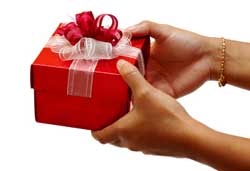 Giving
a gift can be such a joy! There's special karma that goes on during the
process of gift giving. The intended recipient comes to mind, their
enjoyments and interests roll around as the possibilities of delighting
them with a gift solidify. What an honor it is to have friends and
family to gladden with a gift. It really is the thought that counts! Giving
a gift can be such a joy! There's special karma that goes on during the
process of gift giving. The intended recipient comes to mind, their
enjoyments and interests roll around as the possibilities of delighting
them with a gift solidify. What an honor it is to have friends and
family to gladden with a gift. It really is the thought that counts!
Everyone Eats
- Of course, we think we're the perfect store for everyone on your list
- after all, everyone needs to eat, and we're all about fulfilling that
basic need in some way! Trends show that more and more of us are
cooking and eating at home. Sometimes it's for economizing purposes, or
for healthier food choices, or a revived hobby. Regardless, the kitchen
is experiencing a renaissance!

Offer Tools for New Skills
- "Feeding" cooking skills, novice or experienced, with some
inspirational gear is right in style! Sometimes it's that unique piece
of equipment that inspires a new skill or specialty. Other times, it's
about having appropriate gear needed for achieving good results easily.
Specialty Foods
- And, if your intended is not an experienced or emerging cook, you'll
find we have a host of food gift choices that will delight and satisfy.
Our selection of gourmet food items make great stocking stuffers, or
together form a delicious basket of goodies. We'd be pleased to help
you choose just the right combination of items that are sure to delight.
Gift Registry - Our gift registry is not just for weddings, it's for anyone
with a wish list. If you'd like to drop some hints to your Santa, we'd
be happy to be the go-between! We recommend noting a number of items
that allows the giver to choose - this keeps the element of surprise
alive!
 Gift Certificates - Our gift certificates are a perfect solution for everyone - every age, every interest, and every palate. Gift Certificates - Our gift certificates are a perfect solution for everyone - every age, every interest, and every palate.
Free Gift Wrapping
- To simplify your life, and to complete your shopping in one swoop, we
offer gift wrapping for free. We'll prepare your choice and dress it up
just right! You'll be done with your holiday gift shopping in just one
trip to our store!
|
Becoming Candy
|
Sugar
is pure fuel. We're genetically programmed to like "sweet" because it
quickly enters our body providing immediate carbohydrates for our brain
functions and muscle movements. Understanding some fundamentals about
sugar will greatly aid your comfort level with candy making. Here are
some basics to get you started:
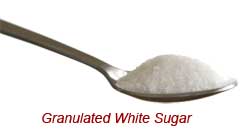 Sugar Chemistry
- Just a tiny bit of chemistry helps to explain candy. Sugar is
sucrose,12 carbon atoms, 22 hydrogen, and 11 oxygen atoms, arranged in
a crystalline, compound structure of two simpler molecules, fructose
and glucose. Sucrose molecules at room temperature want to lock
together to form crystals. Depending on the type of candy being made,
this urge to link up and crystallize is good as with fudge or fondants,
and bad when making lollipops, taffy or caramels. Sugar Chemistry
- Just a tiny bit of chemistry helps to explain candy. Sugar is
sucrose,12 carbon atoms, 22 hydrogen, and 11 oxygen atoms, arranged in
a crystalline, compound structure of two simpler molecules, fructose
and glucose. Sucrose molecules at room temperature want to lock
together to form crystals. Depending on the type of candy being made,
this urge to link up and crystallize is good as with fudge or fondants,
and bad when making lollipops, taffy or caramels.
Dissolving Sugar
- In candy making, sugar is dissolved in water. The water dissolves the
crystals into more individual molecules. There is a point where
additional sugar in a defined amount of water will no longer dissolve.
This is known as the saturation point. But, heat changes the saturation point. As the water and sugar mixture warms, more sugar can be dissolved. This is known as supersaturation - the magical key to candy making!
Preventing Crystals
- The sugar water heated into a supersaturated state desperately wants
to "lock arms" and crystallize; the candy makers' task is to interfere
with that urge. Crystallization can be slowed or prevented in one of
three ways:
 (1) Tip the ratio
- Many candy recipes call for adding corn syrup which is primarily
glucose. Having more glucose molecules hanging around changes the
original ratio of one fructose molecule and one glucose molecule needed
to make the crystal-loving sucrose molecule. By crowding the field with
extra glucose, the formed sucrose molecules have a more difficult time
finding each other and joining into crystals.(2) Add some butter
- Some candy recipes feature butter which also serves to muddle in the
sugar water mixture preventing it from crystallizing. Hard brittles and
toffee use butter to interrupt crystallization, and to add flavor and a
texture that easily cracks in the hand and mouth.(3) Change the pH
- The inclusion of an acidic component breaks the sucrose bonds between
the fructose and glucose molecules and prevents them from reforming.
The result is a liquid sugar form known as invert sugar. Common acidic
ingredients in candy making include lemon juice or cream of tartar. (1) Tip the ratio
- Many candy recipes call for adding corn syrup which is primarily
glucose. Having more glucose molecules hanging around changes the
original ratio of one fructose molecule and one glucose molecule needed
to make the crystal-loving sucrose molecule. By crowding the field with
extra glucose, the formed sucrose molecules have a more difficult time
finding each other and joining into crystals.(2) Add some butter
- Some candy recipes feature butter which also serves to muddle in the
sugar water mixture preventing it from crystallizing. Hard brittles and
toffee use butter to interrupt crystallization, and to add flavor and a
texture that easily cracks in the hand and mouth.(3) Change the pH
- The inclusion of an acidic component breaks the sucrose bonds between
the fructose and glucose molecules and prevents them from reforming.
The result is a liquid sugar form known as invert sugar. Common acidic
ingredients in candy making include lemon juice or cream of tartar.
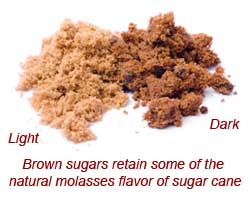 Granulated Sugar
- this is regular white table sugar, the kind that most frequently
comes to mind. The sugar crystals are somewhat irregular cubes. It does
not need to be sifted or packed when measuring, simply poured or
weighed. Granulated Sugar
- this is regular white table sugar, the kind that most frequently
comes to mind. The sugar crystals are somewhat irregular cubes. It does
not need to be sifted or packed when measuring, simply poured or
weighed.- Superfine Sugar
- this is regular white table sugar but crushed to a finer particle
size. Alternatively termed "bar sugar" or "caster sugar," its small
size allows it to dissolve very quickly.
- Confectioner's Sugar
- this sugar is white sugar ground into a powder, hence the alternate
name, "powdered sugar." Many powdered sugars contain cornstarch to
prevent clumping and caking. This form of sugar dissolves nearly
instantly.
- Brown Sugar
- this type of sugar retains some of the natural brown molasses
resulting from processing the sugar cane. Dark brown sugar contains
more residual molasses than light brown sugar. Use dark brown sugar
where the stronger flavor matches well with spices as in gingerbread.
Use light brown sugar where the more delicate taste is complementary
and does not compete with the other flavors.
- Raw Sugar
- this form of sugar typically comes from sugarcane sources and also
has some of the natural brown molasses components remaining from
processing. The residual molasses gives raw sugar its amber color and
slight molasses taste.
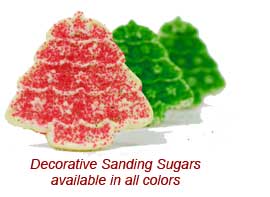 Types of raw sugar include demerara sugar, Muscovado sugar, Barbados sugar, and Turbinado sugar. Types of raw sugar include demerara sugar, Muscovado sugar, Barbados sugar, and Turbinado sugar. - Decorative or Sanding Sugar
- these sugars are coarse, large crystals often colored in liquid form
and allowed to crystallize. The large crystals keep the sugar from
dissolving when heated or in contact with moisture making them perfect
for topping cookies, muffins and other baked goods.
|
Catching the Magical Moment
|
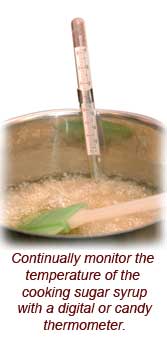 Sugar
is the primary component of candy, but that sugar can take several
forms and yield different characteristics based on how it's handled in
the kitchen. As a sugar solution is heated, the water evaporates
changing the concentration of sugar. Determining exactly when a sugar
solution is prime for the next step is the magic of candy making. Sugar
is the primary component of candy, but that sugar can take several
forms and yield different characteristics based on how it's handled in
the kitchen. As a sugar solution is heated, the water evaporates
changing the concentration of sugar. Determining exactly when a sugar
solution is prime for the next step is the magic of candy making.
Temperature, Temperature, Temperature
- Sugar changes internal structure when heated to very specific heat
levels. The changes may not be obvious at the time the solution reaches
a particular temperature, but will clearly affect the final cooled
product. A traditional glass candy thermometer may be used to monitor
the bubbling sugar solution. Or, for ease and accuracy use a digital
thermometer to track progress.
Assess Texture
- A test of the sugar's progress can be made by cooling droplets of the
sugar solution in cold water and noting its characteristics. The longer
the boiling, the more water that evaporates leaving a denser sugar
liquid able to crystallize to greater and greater degrees when cooled.
The following nine categories are standard definitions when cooking
sugar:
A Couple of Cautions:
At each of these stages, the syrup is hotter than boiling water and can
cause burns if not careful. It may take some time for the sugar syrup
to reach 320°F, but it will reach the higher temperatures very quickly
after that point.
|
Smart Candy Making Tips
|
Tip #1: If there ever was an occasion for mise en place,
it's when making candy. Timing is often critical; having adequate
working space cleared and the right equipment at hand before beginning
is crucial. Wash, dry, and prep any pans or molds as the first step.
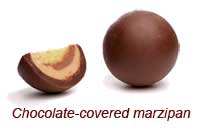 Tip #2: For a very quick gift
from your kitchen, make chocolate-covered anything! Cover or partially
dip pretzels, dried fruit, candied citrus peel, mini-shortbread
cookies, marzipan, or even peanut butter sandwiched between two crackers. Tip #2: For a very quick gift
from your kitchen, make chocolate-covered anything! Cover or partially
dip pretzels, dried fruit, candied citrus peel, mini-shortbread
cookies, marzipan, or even peanut butter sandwiched between two crackers.
Tip #3:
When taking the temperature of a liquid in a saucepan, the position of
the thermometer makes a critical difference. Make sure the tip of the
thermometer is at least one inch from the side of the saucepan, and at
half the height of the liquid. Do not allow the thermometer to touch
the bottom, 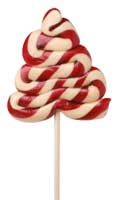 it will register too hot; if too close to the pan's sides it may register too cool. it will register too hot; if too close to the pan's sides it may register too cool.
Tip #4: The cooling and final
handling of sugar syrups can be greatly affected by the room
temperature. If too cold, the candy may cool and harden more quickly
than the time it takes to pull or cut. Similarly, if the candy calls
for warm handling, as in taffy, make separate single batches instead of
doubling the recipe.
Tip #5:
When making candy, measuring the ingredients accurately - there's some
serious kitchen chemistry going on where preciseness will pay off in
excellent results.
|
Q & A's
|
 Q: What ever happened to sugar cubes? Q: What ever happened to sugar cubes?
A:
Sugar cubes, or "lumps," used to be the standard on tables everywhere;
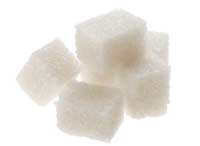 they've been replaced with individual serving packets. You can
make your own sugar cubes or molds by taking granulated sugar and
adding a very small amount of water, (1 T. for each cup of sugar), and
packing the mixture, (that now resembles moist beach sand), into
miniature decorative molds and letting them air dry
until hardened. Add a drop of food coloring as part of the water amount
if desired. they've been replaced with individual serving packets. You can
make your own sugar cubes or molds by taking granulated sugar and
adding a very small amount of water, (1 T. for each cup of sugar), and
packing the mixture, (that now resembles moist beach sand), into
miniature decorative molds and letting them air dry
until hardened. Add a drop of food coloring as part of the water amount
if desired.
Q: Often times you'll read a recipe that encourages you to wash the sides of the saucepan with a brush dipped in water. Why?
A:
The brush and water dissolve any crystals that may have formed on the
rim of the pan. This prevents these crystals from becoming seed
crystals, or platforms for beginning crystallization throughout the
mixture.
Q: What is stevia?
A:
Stevia is a South American shrub whose leaves have a natural sweetness.
The sweetness of stevia registers on our palates as a very concentrated
sensation which means very little is needed to sweeten our foods.
Q: What's the best way to store my homemade candies?
A:
The proper solution will depend on the type of candy. In general, fresh
candy likes to be kept in a dry environment. 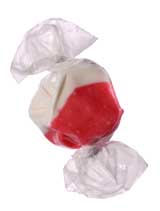 Sticky candies, like
caramels and taffy, are best individually wrapped in wax paper
wrappers. Less sticky candies can be wrapped in foil squares. Fluted
paper or foil cups hold individual pieces neatly. Sticky candies, like
caramels and taffy, are best individually wrapped in wax paper
wrappers. Less sticky candies can be wrapped in foil squares. Fluted
paper or foil cups hold individual pieces neatly.
Q: If a recipe calls for one cup of granulated sugar, can I substitute an equal amount of superfine sugar or powdered sugar?
A:
It depends on the recipe and the sugar's role in the recipe. The volume
of each type of sugar varies in the yielded quantity of sweetness. For
example, one cup of granulated sugar equals 1-3/4 cup powdered sugar.
For candy making it's best to stick with the specified form and
quantity of the sugar listed.
|
|
Cookbook Review
|
A Baker's Field Guide to Holiday Candy & Confections, Sweet Treats All Year Long by Dede Wilson. Copyright 2005. Published by Harvard Common Press, Boston, MA.
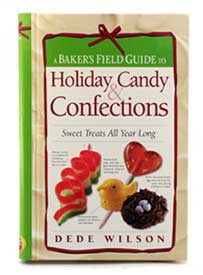 If
you're intrigued with candy making, this is the perfect cookbook for
getting started and also for expanding your skills. This catalog of
recipes introduces all of the basic candy making techniques ranging
from soft nougats and fudge, to hard, glittery lollipops. With the
theme of holidays, the offerings span New Year's, Valentine's Day,
Purim, Easter, Halloween, Hanukkah, Christmas and fourteen other annual
occasions. The recipes build on classic candy favorites, ethnic
traditions, and some new, unique ideas. Each recipe is tagged with
indicators noting the ease of the recipe, whether it's suitable for
kids, the time involved, if it stores and mails well, and a host of
other insights. The instructions and annotations are complete without
being complicated. The result is an enabled cook made comfortable with
candy making techniques. We started our education with the three
recipes below which now has us empowered to try some more of our
favorite candies - Ribbon candy, Turkish delight, Peppermint Patties,
Chocolate-covered Pralines, Panforte di Siena, Marzipan, Cherry
Lollipops, Divinity, Butter Mints . . . . If
you're intrigued with candy making, this is the perfect cookbook for
getting started and also for expanding your skills. This catalog of
recipes introduces all of the basic candy making techniques ranging
from soft nougats and fudge, to hard, glittery lollipops. With the
theme of holidays, the offerings span New Year's, Valentine's Day,
Purim, Easter, Halloween, Hanukkah, Christmas and fourteen other annual
occasions. The recipes build on classic candy favorites, ethnic
traditions, and some new, unique ideas. Each recipe is tagged with
indicators noting the ease of the recipe, whether it's suitable for
kids, the time involved, if it stores and mails well, and a host of
other insights. The instructions and annotations are complete without
being complicated. The result is an enabled cook made comfortable with
candy making techniques. We started our education with the three
recipes below which now has us empowered to try some more of our
favorite candies - Ribbon candy, Turkish delight, Peppermint Patties,
Chocolate-covered Pralines, Panforte di Siena, Marzipan, Cherry
Lollipops, Divinity, Butter Mints . . . .
|
|
Three Candy Recipes
|
Recipes excerpted from A Baker's Field Guide to Holiday Candy & Confections
by Dede Wilson. Copyright 2005. Published by Harvard Common Press,
Boston, MA. Reprinted with permission of the publisher. All rights
reserved.
Star-Shaped Marshmallows
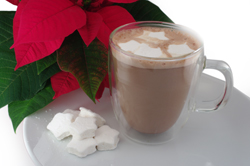
Homemade marshmallows are so different than poofy grocery store versions, that
one or the other should have a different name! Making these
marshmallows was deceptively easy. The basic recipe calls for vanilla,
but we can easily see a peppermint version being equally delicious in
our cocoa or out of hand. Customized variations are easily accomplished
with different cookie cutter shapes,
colored topping sugars, or partial
dipping in chocolate.
Click here for to view the full, illustrated recipe.
Click here for a printable version of the recipe.
Saltwater Taffy

We
had to choose this recipe just for the childhood memories it evoked. A
taffy pull is a great social activity because it takes a few extra
hands to pull and work the taffy before it cools. The stretching
incorporates air and helps to give the taffy its chewy texture. If your
kids or grandkids have never experienced a taffy pull, it's time to
introduce them to this old-fashioned fun!
Click here for to view the full, illustrated recipe.
Click here for a printable version of the recipe.
Sugarplums
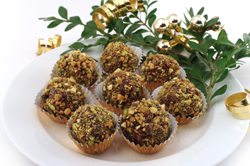
Contrary
to its name, these sugarplums don't contain any sugar, but get their
sweetness from natural dried fruits. A variety of fruits and nuts are
chopped finely in a food processor, formed into balls, then rolled in
nuts or coconut. They are delicious and a healthy sweet when made with
orange juice, or more decadent when made with rum!
Click here for to view the full, illustrated recipe.
Click here for a printable version of the recipe.
|
 |
Sweet dreams and holiday wishes from our kitchen to yours!
|
|
Lorraine, Katie, and all of the Staff at Beyond Pots and Pans
|
|
|
|
|